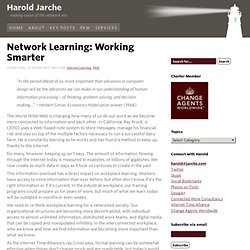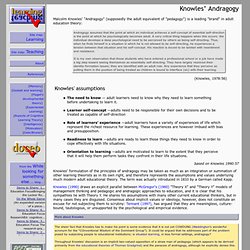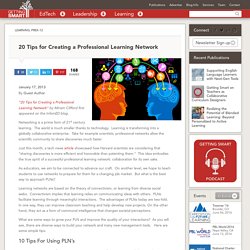

PLN. Network Learning: Working Smarter. “In the period ahead of us, more important than advances in computer design will be the advances we can make in our understanding of human information processing – of thinking, problem solving, and decision making…” ~ Herbert Simon, Economics Nobel-prize winner (1968) The World Wide Web is changing how many of us do our work as we become more connected to information and each other.

In California, Ray Prock, Jr. (2010) uses a Web-based note system to store messages, manage his financial risk and stay on top of the multiple factors necessary to run a successful dairy farm. He is constantly learning as he works and has found a method to keep up, thanks to the Internet. For many, however, keeping up isn’t easy. The amount of information flowing through the Internet today is measured in exabytes, or billions of gigabytes. This information overload has a direct impact on workplace learning. We need to re-think workplace learning for a networked society. Network Learning Seeking: Using Filters.
2005_KBTheory.rtf. Knowles' andragogy: an angle on adult learning. Malcolm Knowles' "Andragogy" (supposedly the adult equivalent of "pedagogy") is a leading "brand" in adult education theory: Andragogy assumes that the point at which an individual achieves a self-concept of essential self-direction is the point at which he psychologically becomes adult.

A very critical thing happens when this occurs: the individual develops a deep psychological need to be perceived by others as being self-directing. Thus, when he finds himself in a situation in which he is not allowed to be self-directing, he experiences a tension between that situation and his self-concept. His reaction is bound to be tainted with resentment and resistance. It is my own observation that those students who have entered a professional school or a job have made a big step toward seeing themselves as essentially self-directing.
Knowles' assumptions The need to know — adult learners need to know why they need to learn something before undertaking to learn it. based on Knowles 1990:57. 20 Tips for Creating a Professional Learning Network - Getting Smart by Miriam Clifford. “20 Tips for Creating a Professional Learning Network” by Miriam Clifford first appeared on the InfomED blog.

Networking is a prime form of 21st century learning. The world is much smaller thanks to technology. Learning is transforming into a globally collaborative enterprise. Take for example scientists; professional networks allow the scientific community to share discoveries much faster. Just this month, a tech news article showcased how Harvard scientists are considering that “sharing discoveries is more efficient and honorable than patenting them.” As educators, we aim to be connected to advance our craft. How Technology Helps Build a Personal Learning Network. Technology has become an integral part of classroom life.

While students certainly reap the benefits of having a wealth of information at their fingertips, teachers like you can also capitalize on technology’s many uses. New and veteran teachers alike can utilize the Internet to build their Personal Learning Networks, gaining classroom know-how and connections that will help advance your career. What is a Personal Learning Network? Unlike your classroom, your Personal Learning Network (PLN) is available to you seven days a week, 24 hours a day. It consists of all of the educational sites that you join to have discussions with other educators and find classroom resources. You can participate in scheduled chats on Twitter, write and comment on educational blogs, and join websites that offer discussion forums and other resources.
Twitter Twitter is one of the best tools for building your PLN. Blogging Blogging has become incredibly popular in classrooms. Other Resources. How to cultivate a personal learning network.